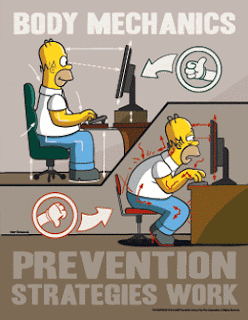
There are three contact areas in the work space that affect the worker's posture: the seat, the work surface (commonly it is a desk top or keyboard) and the floor. To ensure the most comfortable posture possible, two of these factors have to be adjustable.
If you can afford to do nothing else, a fully adjustable chair is the undisputable "must". The other, and perhaps the most preferable option, would be a fully adjustable desk. However the price of such a desk may not make this option practical. Another effective (and cheaper) option is to use an adjustable chair and footrest to secure postural comfort.
What Kind of Ergonomic Office Chair is Best?
There are many types of ergonomic chairs available for use in the office. No one type of office chair is necessarily the best, but there are some things that are very important to look for in a good ergonomic office chair. These things will allow the individual user to make the chair work well for his or her specific needs.
This article will examine the traditional office chair, as well as alternatives that can be used as an office chair that may be preferable for some people with back problems.
What Features Should a Good Ergonomic Office Chair Possess?
In first considering the "conventional" style of office chair, there are a number of things an ergonomic chair should have, including:
- Seat height. Office chair seat height should be easily adjustable. A pneumatic adjustment lever is the easiest way to do this. A seat height that ranges from about 16 to 21 inches off the floor (knee height) should work for most people. This allows the user to have his or her feet flat on the floor, with thighs horizontal and arms even with the height of the desk.
- Seat width and depth. The seat should have enough width and depth to support any user comfortably. Usually 17-20 inches wide is the standard. The depth (from front to back of the seat) needs to be enough so that the user can sit with his or her back against the backrest of the ergonomic office chair while leaving clenched fist (approximately 2 to 4 inches) between the back of the knees and the front edge of the seat. The forward or backward tilt of the seat should be adjustable.
- Lumbar support. Lower back support in an ergonomic chair is very important. The lumbar spine has an inward curve, and sitting for long periods without support for this curve tends to lead to slouching (which flattens the natural curve) and strains the structures in the lower spine. An ergonomic chair should have a lumbar adjustment (both height and depth) so each user can get the proper fit the hollow in your lower back.
- Backrest. The backrest of an ergonomic office chair should be 12 to 19 inches wide. If the backrest is separate from the seat, it should be adjustable in height and angle. It should be able to support the natural curve of the spine, again with special attention paid to proper support of the lumbar region. If the office chair has the seat and backrest together as one piece, the backrest should be adjustable in forward and back angles, with a locking mechanism to secure it from going too far backward once the user has determined the appropriate angle.
- Seat material. The material on the office chair seat and back should have enough padding to be comfortable to sit on for extended periods of time. Having a cloth fabric that breathes is preferable to a harder surface.
- Armrests. Office chair armrests should be adjustable. They should allow the user's arms to rest comfortably and shoulders to be relaxed. The elbows and lower arms should rest lightly, and the forearm should not be on the armrest while typing.
- Swivel. Any conventional style or ergonomic chair should easily rotate so the user can reach different areas of his or her desk without straining.
Once your chair is properly adjusted for your height, check if you can sit at the workstation comfortably with your legs crossed underneath.
- If you cannot fit your legs under the workstation or there is not enough space to move them freely, your workstation is too low for you and you should not use such a workstation on a regular basis!
- If you can sit comfortably but need to elevate your arms in order to place them over the work surface, your workstation is too high. Adjust the chair height so your elbows are about the same height as the work surface. Use a footrest if you cannot place your feet flat on the floor.
- The footrest should be adjustable and support both feet. Keep feet flat and firm on the footrest.






1 Comments